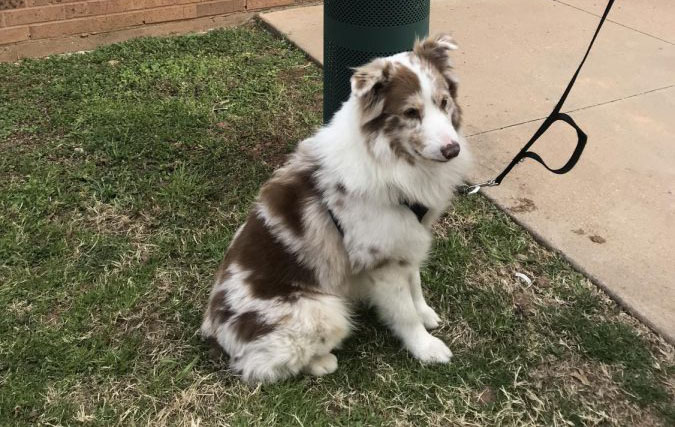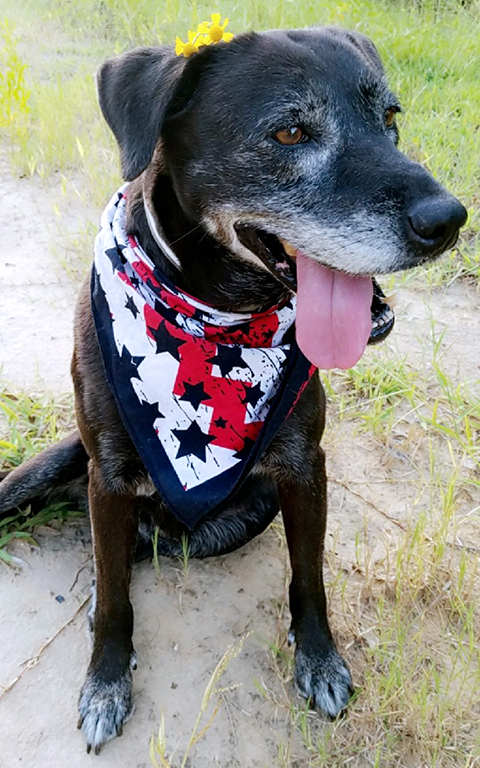Animals provide emotional support for 15 students on campus
Megan Baltusis’, early childhood education junior, dog, Crockett, in front of the pet waste disposal station in Sunwatcher Village.
The residence halls aren’t home for college students alone.
Up and down the hallways also roam dogs and cats, animals providing emotional support for the 15 students with them on campus this year.
Kristi Schulte, director of residence life and housing, said these animals are neither service animals nor pets.
“It’s important for people to understand these animals are here to do a very specific job and to be mindful of the differences between an ESA and a service animal,” Schulte said. “A support animal comes to campus because they have a job, to provide support to their owner or handler.”
Keith Lamb, vice president of student affairs, acknowledges that ESAs are for student’s well-being and benefit. He said, making sure that the student gets their animal on campus is crucial.
“If emotional support animals help our students who need them be successful, then keeping that student on campus is a benefit,” Lamb said.
To get a support animal, students must first have an established relationship with a therapist for their disability. Then, their therapist must explain why they would benefit from an emotional support animal. With proper documentation, the student is then able to bring the information to the Disabilities Support Services to get their animal on campus.
Jaylon Williams, sociology graduate, is familiar with the process of approval on campus. Williams shared her thoughts about the process.
“I wouldn’t say to make the process stricter, but they need to be more vigilant. Most people register their dogs as ESA just so they can have them on campus,” Williams said. “People need to understand that when you abuse the system, it makes it harder for those of us who actually need our ESAs.”
Debra Higginbotham, disability support services director said the process is long and strict to help prevent people from falsifying information to get their animal on campus. The Disabilities Support Service is where the documentation and verification of the disability is kept. However, through their services they aren’t allowed to recommend a person with a disability or mental illness to get an ESA.
“We don’t do any documentation for students because I’m not doing therapy with students and it comes from a therapist who believes that’s a good treatment,” Higginbotham said.
Megan Baltusis, early childhood education junior, who has had her emotional support dog for two months says, that her main issue with the process is that she had to first be established with an off-campus counselor. The counselors on campus can’t recommend ESA’s.
“You have to be established with a counselor for a while, so they make sure you are diagnosed with some sort of disability you would benefit having an animal from,” Baltusis said.
ESAs are life changing and can help with disabilities like nothing else can, Baltusis said. It is important for people to understand that the people with ESA’s have mental illness, and at times she feels that is disregarded.
“I wish people were more open to the idea of what they actually do for us,” Baltusis said. “He, her dog, has helped me so much with my anxiety and depression and I couldn’t imagine not having him around.”
Baltusis is not alone when she said her ESA has changed her life. Williams, who had her ESA for 12 years, said she cannot imagine what her life would have been without her ESA.
“Sometimes medication and therapy may not be enough,” Williams said. “I grew up with my dog, Cocoa, so the connection I had with her was strong. I didn’t have to teach her really. Most of the help she gave me were things she just picked up on her own.”
While Schulte said she believes that ESAs are beneficial, she also said it’s important for the owner to properly care for the animal, so that the housing staff doesn’t have a problem with damage to property.
“When we have really responsible animal owners who are attending to their animals and making sure that they’re walked enough and get enough exercise, they tend to not have any problems [with destruction],” Schulte said.
Dogs and cats are the primary animals that people have and while cats are low maintenance, dogs are not. As college students, Lamb said it’s critical the owner is committed to the animal and is willing to put the time in to give the animal a good quality of life.
“An important part of the education is to understand it need to be a mutually beneficial relationship,” Lamb said. “The relationship between the ESA and an individual should not only benefit the individual but the animal as well.”
For Baltusis, her emotional support dog forces her to have a schedule and to have someone that relies on her. It is important that she has something that helps her get out of bed when she doesn’t want to, even on her worst days.
“My dog, Crockett, is always super excited when I get home, so it’s great to have someone that is always looking forward to see you,” Baltusis said. “He is truly the best!”
CORRECTION: In a previous version of this story we misspelled Megan Baltusis’s name. The Wichitan regrets this error.









